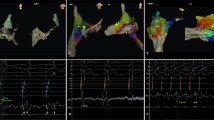Abstract
Background
As there are limited data about the clinical practice of catheter ablation in asymptomatic children and adolescents with ventricular preexcitation on ECG, we performed the multicenter “CASPED” (Catheter ablation in ASymptomatic PEDiatric patients with Ventricular Preexcitation) study.
Methods and results
In 182 consecutive children and adolescents aged between 8 and 18 years (mean age 12.9 ± 2.6 years; 65% male) with asymptomatic ventricular preexcitation, a total of 196 accessory pathways (APs) were targeted. APs were right sided (62%) or left sided (38%). The most common right-sided AP location was the posteroseptal region (38%). Ablation was performed using radiofrequency (RF) energy (93%), cryoablation (4%) or both (3%). Mean procedure time was 137.6 ± 62.0 min with a mean fluoroscopy time of 15.6 ± 13.8 min. A 3D mapping or catheter localization system was used in 32% of patients. Catheter ablation was acutely successful in 166/182 patients (91.2%). Mortality was 0% and there were no major periprocedural complications. AP recurrence was observed in 14/166 patients (8.4%) during a mean follow-up time of 19.7 ± 8.5 months. A second ablation attempt was performed in 20 patients and was successful in 16/20 patients (80%). Overall, long-term success rate was 92.3%.
Conclusion
In this retrospective multicenter study, the outcome of catheter ablation for asymptomatic preexcitation in children and adolescents irrespective of antegrade AP conduction properties is summarized. The complication rate was low and success rate was high, the latter mainly depending on pathway location. The promising results of the study may have future impact on the ongoing risk–benefit discussion regarding catheter ablation in the setting of asymptomatic preexcitation in children and adolescents.

Similar content being viewed by others
References
Obeyesekere MN, Leong-Sit P, Massel D, Manlucu J, Modi S, Krahn AD, Skanes AC, Yee R, Gula LJ, Klein GJ (2012) Risk of arrhythmia and sudden death in patients with asymptomatic preexcitation: a meta-analysis. Circulation 125(19):2308–2315
Chevalier P, Cadi F, Scridon A, Girerd N, Bejan-Angoulvan T, Morel E, Hot IJ, Di Filippo S, Ganne C, Colin C (2013) Prophylactic radiofrequency ablation in asymptomatic patients with Wolff–Parkinson–White is not yet a good strategy: a decision analysis. Circ Arrhythm Electrophysiol 6(1):185–190
Saul JP, Kanter RJ (2016) PACES/HRS expert consensus statement on the use of catheter ablation in children and patients with congenital heart disease. Heart Rhythm 13:258–259
Pappone C, Vicedomini G, Manguso F, Saviano M, Baldi M, Pappone A, Ciaccio C, Giannelli L, Ionescu B, Petretta A, Vitale R, Cuko A (2014) Wolff–Parkinson–White syndrome in the era of catheter ablation: insights from a registry study of 2169 patients. Circulation 2 130(10):811–819
Sarubbi B, D’Alto M, Vergara P, Calvanese R, Mercurio B, Russo MG, Calabrò R (2005) Electrophysiological evaluation of asymptomatic ventricular pre-excitation in children and adolescents. Int J Cardiol 15(2):207–214
Cohen MI (2012) PACES/HRS Expert consensus statement on the management of the asymptomatic young patient with a Wolff–Parkinson–White (WPW, ventricular preexcitation) electrocardiographic pattern. Heart Rhythm 9:1006–1024
Di Mambro C, Russo MS, Righi D, Placidi S, Palmieri R, Silvetti MS, Gimigliano F, Prosperi M, Drago F (2015) Ventricular pre-excitation: symptomatic and asymptomatic children have the same potential risk of sudden cardiac death. Europace 17(4):617–621
Van Hare GF, Javitz H, Carmelli D, Saul JP, Tanel RE, Fischbach PS, Kanter RJ, Schaffer M, Dunnigan A, Colan S, Serwer G (2014) Pediatric Electrophysiology Society. Prospective assessment after pediatric cardiac ablation: demographics, medical profiles, and initial outcomes. J Cardiovasc Electrophysiol 15(7):759–770
Wong KT, Yung TC, Lun KS, Fan KYY, Chau AKT (2005) Ten-year experience of radiofrequency catheter ablation of accessory pathways in children and young adults. HK J Paediatr 10:257–264
Ceresnak SR, Dubin AM, Kim JJ, Valdes SO, Fishberger SB, Shetty I, Zimmerman F, Tanel RE, Epstein MR, Motonaga KS, Capone CA, Nappo L (2015) Success rates in pediatric WPW ablation are improved with 3-dimensional mapping systems compared with fluoroscopy alone: a multicenter study. J Cardiovasc Electrophysiol 26(4):412–416
Chen TH, Tsai ML, Chang PC, Wo HT, Chou CC, Wen MS, Wang CC, Yeh SJ, Wu D (2013) Risk factors of recurrence and complication in radiofrequency catheter ablation of atrioventricular re-entrant tachycardia in children and adolescents. Cardiol Young 23:682–691
Brugada J, Keegan R (2018) Asymptomatic ventricular preexcitation: between sudden cardiac death and catheter ablation. Arrhythm Electrophysiol Rev 7(1):32–38
Kubuš P, Vít P, Gebauer RA, Materna O, Janousek J (2014) Electrophysiologic profile and results of invasive risk stratification in asymptomatic children and adolescents with the Wolff–Parkinson–White electrocardiographic pattern. Circ Arrhythm Electrophysiol 7(2):218–223
Belhassen B, Rogowski O, Glick A, Viskin S, Ilan M, Rosso R, Eldar M (2007) Radiofrequency ablation of accessory pathways: a 14 year experience at the Tel Aviv Medical Center in 508 patients. Isr Med Assoc J 9(4):265–270
Di Mambro C, Drago F, Milioni M, Russo MS, Righi D, Placidi S, Remoli R, Palmieri R, Gimigliano F, Santucci LM, Silvetti MS, Prosperi M (2016) Sports eligibility after risk assessment and treatment in children with asymptomatic ventricular pre-excitation. Sports Med 46(8):1183–1190
Pappone C, Manguso F, Vicedomini G, Sala S, Paglino G (2004) Radiofrequency ablation in children with asymptomatic Wolff–Parkinson–White syndrome. N Engl J Med 351:1197–1205
Van Hare GF, Javit H, Carmelli D, Saul JP, Tanel RE, Fischbach PS, Kanter RJ, Schaffer M, Dunnigan A, Colan S, Serwer G (2004) Prospective assessment after pediatric cardiac ablation: recurrence at 1 year after initially successful ablation of supraventricular tachycardia. Heart Rhythm 1(2):188–196
Author information
Authors and Affiliations
Corresponding author
Ethics declarations
Conflict of interest
The authors have no conflicts of interest.
Rights and permissions
About this article
Cite this article
Telishevska, M., Hebe, J., Paul, T. et al. Catheter ablation in ASymptomatic PEDiatric patients with ventricular preexcitation: results from the multicenter “CASPED” study. Clin Res Cardiol 108, 683–690 (2019). https://doi.org/10.1007/s00392-018-1397-x
Received:
Accepted:
Published:
Issue Date:
DOI: https://doi.org/10.1007/s00392-018-1397-x




